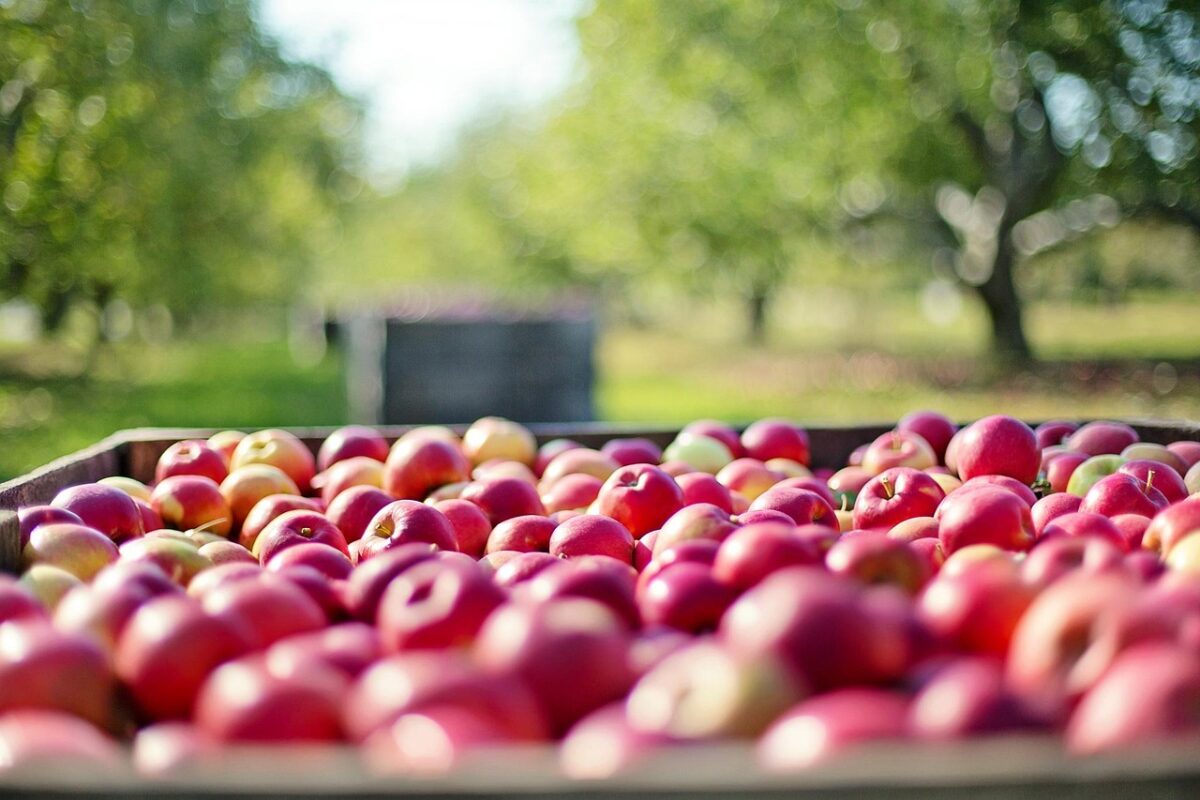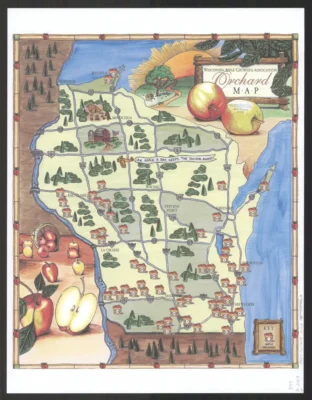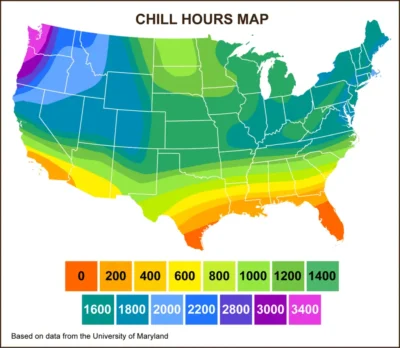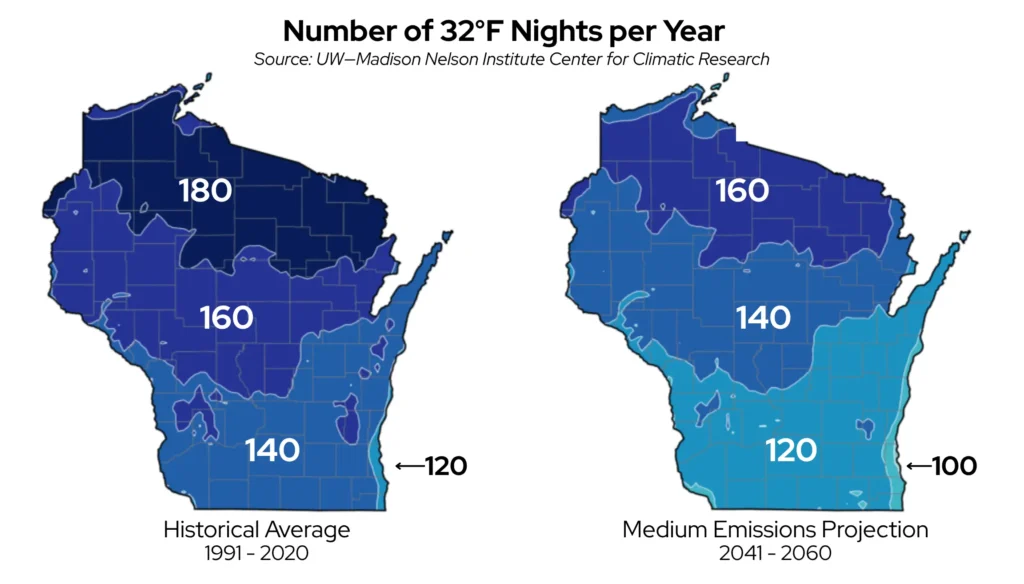
Biting into a nice, crisp McIntosh or Honeycrisp apple that has been grown in a Wisconsin orchard is a real treat anytime from mid-August through late October. Apples are the most widely planted tree fruit in the Badger State because of their hardiness and variety in flavor and texture.
According to the Wisconsin Apple Growers Association, over 30 types of apples are grown in the state.
Nearly 300 commercial apple orchards can be found in 57 of Wisconsin’s 72 counties, covering over 4000 acres, producing 49 million pounds of apples.
History of Apples in Wisconsin
Apples were originally grown for personal use or local markets in Wisconsin during the 18th and 19th centuries.
The industry became commercialized in 1891, when the Wisconsin Horticultural Society began establishing “trial orchards” around the state. These orchards thrived as new varieties were successfully developed in local soils and microclimates.
Orchard Regions
Wisconsin has several clusters of apple-growing regions that have developed due to family history, microclimates, topography, soil type, market location, or land availability.
One of the more famous clusters is found in the Coulee Region of the Driftless Area surrounding Gays Mills (Crawford County), which has become known as the “Apple Capital of Wisconsin.”

The ridges of this region provide natural frost protection for the orchards that sit atop them, and the added height provides abundant sunshine to most trees. The drainage and acidity of the silt loam soils of the region are also beneficial to apple development.
A second cluster is on the Door County Peninsula, which lies between Lake Michigan and the bay of Green Bay. These two bodies of water create a favorable microclimate for apple growing, as well as the famous tart cherries of the region, by allowing for more moderate temperatures.
A third cluster is found on the Bayfield Peninsula along the southern shore of Lake Superior. Although this peninsula is the northernmost region of the Badger State, it is partially surrounded by cold lake waters that create ideal conditions for apple production. During summer, this area also benefits from the stabilizing effects of the Great Lakes that tend to reduce thunderstorm frequency.
Growing Season
It takes over a year for apple tree buds to turn into fruit. Buds form during the summer, then hibernate and become dormant over the winter season. Buds then break and flower the following spring, and finally, fruit develops and matures during the fall.
Apple trees need a sufficiently long and consistent cold winter to conserve energy for the following growing season.
One of the ways to monitor this chilling requirement is with “chill hours” — a metric of the amount of time that a tree is exposed to temperatures between 32 and 45 degrees Fahrenheit during the winter.
When the needed chill hours are met, the tree breaks out of hibernation with the opening of flower buds that set fruit in spring, hopefully when the chance of frost has been reduced. By then, the tree needs temperatures above 50 degrees to resume active growth and bloom.

If not enough chilling hours are accrued during winter, the dormant season is shortened, causing the tree to have poor fruit because of a lack of blossoms or delayed flowering.
Different types of apples require different amounts of chilling hours. Wisconsin is fortunate to have a cool enough climate to support high-chill apple varieties, with an average of 1400 chill hours per winter.
The Midwestern Regional Climate Center provides information that is vital to apple growers by providing an interactive Chilling Hours Tool that allows the tracking of chill hour accumulations at varying locations. This information can help determine whether their harvest will be barren or bountiful.
Weather Impacts On The Apple Crop
Weather extremes can impact Wisconsin’s apple crops in many of the stages of the growth cycle of the trees, especially during the spring bloom season when the trees are most vulnerable. Apple trees are particularly sensitive to changes in soil conditions, temperature, and pests — requiring conditions to be just right for ideal growing conditions.
Spring
Late spring frosts or freezes can damage blossoms. Warm winters and early springs lead to earlier budding, increasing the plant’s vulnerability to late spring frosts.
Such a situation occurred in 2012, when the state experienced a record warm March that encouraged early blossoming on apple trees in many areas. A killing frost in mid-April disrupted pollination and cut Wisconsin’s apple yields in half come autumn.
On the opposite end, a cool spring can delay pollinator activity, resulting in fewer apples. Prolonged cold weather during spring and summer can lead to cold damage, making apple trees vulnerable to secondary diseases.
Some apple growers in northeastern Wisconsin reported cold damage to their trees in spring 2025 as the cool weather reduced bee activity, which affected pollination of the blossoms.
Summer
Thunderstorms accompanied by large hail and high winds can damage trees, blossoms, and fruit, depending on the time of year.
While hot summers can help apples ripen and turn color, long periods of high humidity can increase the prevalence of pests and pathogens in the orchard that affect fruit quality.
A drought, regardless of season, can stress trees, making them more susceptible to disease. On the other hand, apple trees do not like soil conditions that are too wet.
Fall and Winter
On occasion, a hard freeze in autumn can be devastating to apple trees, especially during a warm fall. Under these conditions, the sap that was still flowing in the tree freezes in the upper portions of the plant, causing its demise.
Too warm a winter may not provide a sufficient number of chilling hours needed for high-chill apple trees to flower and bear sufficiently.
Conversely, extreme cold temperatures below -20 degrees can damage apple trees. Especially if there’s little snow cover, the tree roots can freeze. Frozen roots prevent the tree from taking up water and nutrients, eventually causing the plant to die.
Fall Harvest
Depending upon the variety, harvesting season across Wisconsin usually begins in late July and runs into early November. Summer varieties of early-season apples, such as Pristine and Ginger Gold, can be harvested from late July through early August.
The main harvest season runs from mid-August through late October, when the most popular varieties are ripe for the picking. Several late-season varieties, such as Granny Smith and Gold Rush, can be harvested into November.
The specific timing for harvesting apples can vary by variety and recent weather conditions. Check with local orchards for updates as to when specific apple varieties are available for picking.
Battling Changes
The projected increased frequency and intensity of extreme weather events due to a changing climate could pose a long-term threat to Wisconsin’s apple trees. More frequent severe thunderstorms, prolonged drought, and unpredictable frost conditions make apple trees more susceptible to damage.
Warmer winters, especially, would reduce the total number of chill hours and disrupt the trees’ growing cycle. Projections from the Center for Climatic Research at UW—Madison show that all areas of the state could see 20 fewer freezing nights per year in the coming years.
